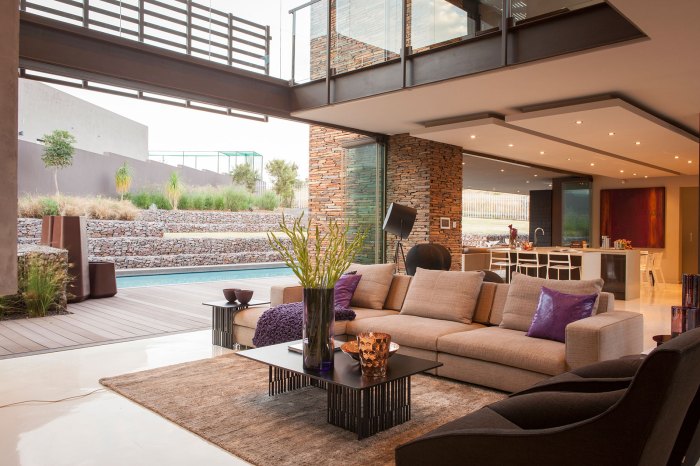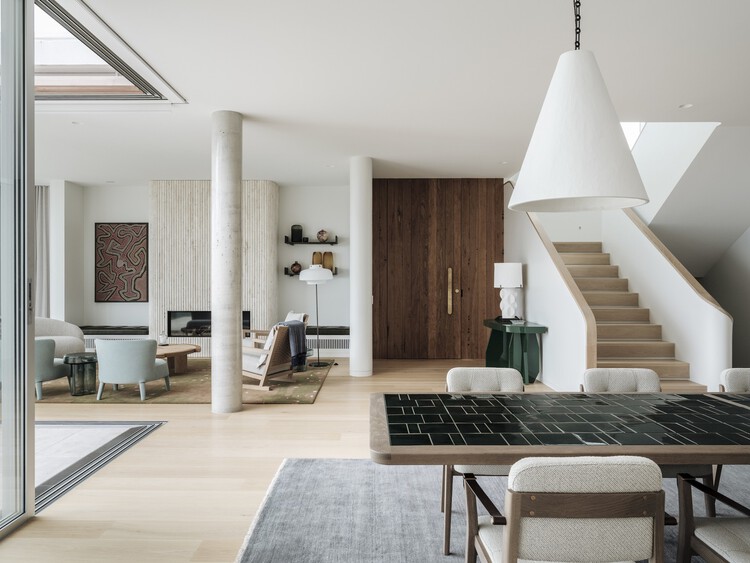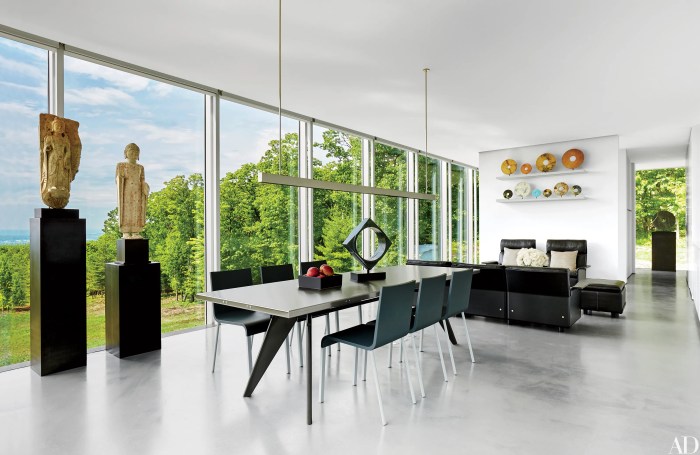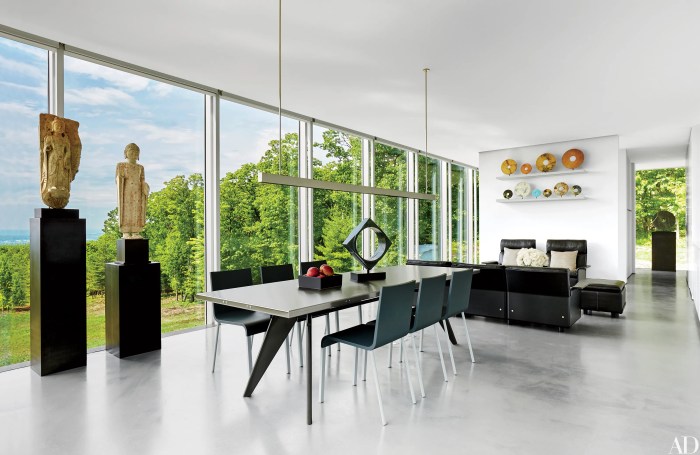Big modern house interior design is more than just expansive spaces; it’s a philosophy of maximizing functionality and aesthetics. This style embraces clean lines, open layouts, and a focus on natural light, transforming large homes into havens of contemporary living.
Imagine a home where every corner reflects a harmonious blend of form and function, where minimalist design meets the demands of spacious living.
This guide delves into the key elements of big modern house interior design, from the core principles of modern aesthetics to practical tips for furniture selection, lighting, and color palettes. We’ll explore how to create a sense of flow and visual interest in expansive spaces, while seamlessly integrating technology and sustainable practices.
Furniture Selection and Arrangement
Furniture selection and arrangement are crucial aspects of modern home design. They not only enhance the functionality and aesthetics of a space but also create a sense of flow and harmony. Carefully chosen furniture pieces, arranged strategically, can transform a large home into a welcoming and inviting sanctuary.
Essential Furniture Pieces for a Modern Large Home
A large home provides ample space to incorporate various furniture pieces, each serving a distinct purpose. The following list highlights some key furniture pieces that are essential for a modern large home interior:
- Modular Sofa:A modular sofa offers flexibility and adaptability, allowing homeowners to customize the configuration to suit their needs and preferences. It’s ideal for large living areas, providing ample seating for guests and family gatherings.
- Statement Chairs:Adding statement chairs with unique designs and textures can add visual interest and personality to a space. They can serve as accent pieces, providing comfortable seating in designated areas like a reading nook or by the fireplace.
- Coffee Table:A coffee table is a focal point in the living room, serving as a surface for drinks, books, and decorative items. Modern coffee tables often feature sleek lines, minimalist designs, and materials like glass, metal, or wood.
- Dining Table:A dining table is essential for formal gatherings and casual meals. Large homes often feature expansive dining tables that can accommodate a large number of guests. Modern dining tables often incorporate minimalist designs and materials like wood, metal, or glass.
- Storage Units:Large homes often require ample storage space to accommodate belongings and maintain order. Modern storage units come in various styles, from sleek cabinets and shelves to multi-functional storage ottomans.
- Rugs:Rugs define areas within a large home and add warmth and texture to the floor. Modern rugs often feature geometric patterns, abstract designs, or minimalist styles.
Furniture Brands and Styles
Several furniture brands and styles embody modern design principles, characterized by clean lines, minimalist aesthetics, and functional designs. Here are some examples:
- Brands:
- Knoll:Known for its iconic mid-century modern designs, Knoll offers a wide range of furniture pieces, including sofas, chairs, and tables, that are both stylish and functional.
- Herman Miller:Herman Miller is another renowned brand that produces high-quality modern furniture, including the iconic Eames Lounge Chair and the Aeron Chair.
- Vitra:Vitra is a Swiss furniture manufacturer that collaborates with renowned designers to create innovative and functional furniture pieces.
- Styles:
- Mid-Century Modern:This style, popularized in the 1950s and 1960s, emphasizes clean lines, organic shapes, and a focus on functionality.
- Scandinavian Modern:Scandinavian modern furniture is characterized by simplicity, functionality, and natural materials like wood and leather.
- Contemporary:Contemporary furniture encompasses a wide range of styles, but it generally features clean lines, minimalist designs, and a focus on comfort and functionality.
Furniture Arrangement for a Large Home
Furniture arrangement plays a crucial role in maximizing space and creating a sense of flow in a large home. The following are some examples of furniture arrangements that can enhance the functionality and aesthetics of a large home:
- Open Floor Plan:Large homes often feature open floor plans that seamlessly connect different areas, such as the living room, dining room, and kitchen. This allows for flexibility in furniture arrangement, creating a sense of spaciousness and flow.
- Zoning:Zoning is a technique used to divide a large space into distinct areas with specific functions. Furniture can be arranged to define these zones, such as a living area, a dining area, and a work area. This creates a sense of order and organization within a large space.
Big modern house interior design often prioritizes clean lines and minimalist aesthetics, but you can also inject a touch of coastal charm. Think about incorporating natural elements like wood and rattan, and consider incorporating a breezy color palette inspired by american beach house interior design , which often features light blues, sandy browns, and crisp whites.
This subtle nod to the beach can bring a sense of relaxation and tranquility to your modern home.
- Focal Point:A focal point is a visually prominent element that draws attention and anchors a space. In a large home, the focal point could be a fireplace, a large window, or a statement piece of furniture. Furniture can be arranged to enhance the focal point and create a sense of balance and symmetry.
- Traffic Flow:Furniture arrangement should facilitate smooth traffic flow throughout the home. Avoid placing furniture in high-traffic areas that obstruct movement or create bottlenecks.
Creating Focal Points and Interest

A large modern house offers a unique opportunity to create captivating spaces with distinct focal points that draw the eye and establish a sense of visual interest. Strategic placement of architectural features, artwork, and decorative elements transforms an expansive interior into a series of engaging areas.
Statement Pieces for Modern Aesthetics
Statement pieces are essential in creating focal points and enhancing the modern aesthetic of a large home. These pieces are designed to capture attention and elevate the overall design scheme. Here are some examples:
- Sculptural Lighting:A large, geometric chandelier or a series of pendant lights in an eye-catching shape can be a dramatic focal point in a spacious living area. For instance, a modern, minimalist chandelier with cascading, geometric forms can create a striking visual impact.
- Bold Furniture:A statement sofa with an unusual silhouette or a vibrant color can instantly define a seating area. A low-profile sofa with clean lines and bold upholstery in a deep teal or emerald green can create a striking contrast against neutral walls.
- Art Installations:Large-scale artwork, such as a contemporary abstract painting or a series of framed prints, can become a dominant feature in a hallway or dining area. A series of black and white photographs in large frames can create a dramatic and modern focal point in a minimalist dining room.
Textural and Pattern Play for Depth and Dimension, Big modern house interior design
Modern interiors often embrace a minimalist aesthetic, but adding texture and pattern can add depth and dimension to a space.
- Textured Walls:Using textured wall coverings, such as wallpaper with a subtle geometric pattern or a textured plaster finish, can add visual interest and create a sense of depth. A textured wall with a subtle geometric pattern in a muted gray can create a sophisticated and understated backdrop for a modern living room.
- Layered Rugs:Layering rugs of different textures and patterns can add visual interest and warmth to a large space. For example, a large, flat-weave rug in a neutral color can be layered with a smaller, patterned rug in a contrasting color to create a dynamic focal point in a living room.
- Natural Materials:Incorporating natural materials, such as wood, stone, and leather, can add warmth and texture to a modern interior. A large, wooden coffee table with a distressed finish can create a natural focal point in a modern living room, while leather accents, such as a statement armchair or a leather-bound book collection, can add a touch of sophistication.
Technology Integration

Technology has become an integral part of modern life, and its impact on home design is undeniable. It enhances functionality, comfort, and even aesthetics, transforming the living experience in large modern houses. Smart home features, seamlessly integrated into the interior design, elevate the level of convenience and create a more efficient and enjoyable living environment.
Smart Home Features
Smart home features enhance the living experience in a large modern house by providing convenience, comfort, and security.
- Smart Lighting:Automated lighting systems can adjust brightness levels based on time of day, occupancy, or even the weather. This creates a more pleasant and energy-efficient environment. For example, smart bulbs can be programmed to dim automatically at night, creating a relaxing ambiance.
- Smart Thermostats:These devices learn your heating and cooling preferences and adjust the temperature accordingly, optimizing energy consumption and comfort. They can also be controlled remotely, allowing you to adjust the temperature before arriving home.
- Smart Security Systems:Integrated security systems offer peace of mind with features like motion sensors, door and window alarms, and video surveillance. These systems can be monitored remotely, providing real-time alerts and allowing you to check in on your home from anywhere.
- Home Automation:Smart home hubs allow you to control various appliances and devices with voice commands or a mobile app. This includes functions like locking doors, adjusting blinds, and controlling entertainment systems, simplifying daily tasks and creating a more seamless living experience.
Sustainability and Eco-Friendly Design: Big Modern House Interior Design

In the realm of modern home interiors, the concept of sustainability has gained significant traction, leading to the integration of eco-friendly design principles that minimize environmental impact while enhancing the overall well-being of occupants. This approach not only aligns with contemporary values but also contributes to a more responsible and sustainable future.
Sustainable Materials and Practices
Sustainable materials and practices play a pivotal role in creating eco-conscious modern homes.
- Recycled and Reclaimed Materials:Incorporating recycled materials, such as reclaimed wood, salvaged bricks, and repurposed metals, reduces the demand for virgin resources and minimizes waste. These materials often possess unique character and patina, adding a distinctive aesthetic to the interior design.
- Locally Sourced Materials:Utilizing materials sourced locally minimizes transportation distances, reducing carbon emissions associated with shipping. This practice also supports regional economies and promotes a sense of place.
- Sustainable Wood:Selecting wood certified by organizations like the Forest Stewardship Council (FSC) ensures that the timber comes from responsibly managed forests that prioritize environmental conservation and social equity. This choice supports sustainable forestry practices and reduces the risk of deforestation.
- Low-VOC Paints and Finishes:Volatile organic compounds (VOCs) released from conventional paints and finishes can contribute to indoor air pollution. Opting for low-VOC or VOC-free alternatives promotes healthier indoor air quality and reduces environmental impact.
- Energy-Efficient Appliances:Selecting appliances with high energy efficiency ratings (such as Energy Star) reduces energy consumption and lowers utility bills. These appliances are designed to perform optimally while minimizing environmental impact.
Benefits of Green Building Principles
Incorporating green building principles into large modern homes offers a multitude of benefits, extending beyond environmental considerations.
Big modern houses often feature expansive open floor plans, showcasing luxurious finishes and bold design choices. But even with limited space, you can achieve a stylish and functional interior in a smaller home. For inspiration on maximizing space in a 1 BHK, check out these clever design ideas for 1 bhk small house interior design.
Ultimately, regardless of the size, a well-designed home should reflect your personal style and create a welcoming atmosphere.
- Reduced Energy Consumption:Green building principles emphasize energy efficiency through strategies such as passive solar design, natural ventilation, and high-performance insulation. These measures contribute to lower energy bills and a smaller carbon footprint.
- Improved Indoor Air Quality:Green building practices prioritize indoor air quality by incorporating materials with low VOC emissions, using natural ventilation systems, and incorporating air filtration technologies. This results in a healthier and more comfortable living environment.
- Enhanced Durability and Longevity:Sustainable materials and construction techniques are often designed for durability and longevity, reducing the need for frequent repairs and replacements. This contributes to a more sustainable building lifecycle.
- Increased Property Value:Homes designed with green building principles often command higher property values due to their energy efficiency, health benefits, and environmental responsibility. This investment can yield long-term financial rewards.
- Positive Social Impact:Sustainable design practices promote social responsibility by supporting local economies, minimizing waste, and creating healthier living environments for occupants. This approach contributes to a more equitable and sustainable society.
Sustainable Design Features
Sustainable design features contribute significantly to energy efficiency and environmental responsibility in large modern homes.
- Passive Solar Design:This approach strategically utilizes solar energy by maximizing sunlight exposure during winter and minimizing heat gain during summer. This can be achieved through south-facing windows, overhangs, and strategically placed trees.
- Natural Ventilation:Integrating natural ventilation systems, such as cross-ventilation and operable windows, allows for fresh air circulation, reducing reliance on mechanical systems and improving indoor air quality.
- Green Roofs:Installing green roofs, covered with vegetation, helps reduce stormwater runoff, improve insulation, and create a habitat for wildlife. These roofs also contribute to a more aesthetically pleasing and sustainable design.
- Water-Saving Fixtures:Utilizing water-efficient fixtures, such as low-flow showerheads and toilets, reduces water consumption without compromising functionality. This practice contributes to water conservation and reduces environmental impact.
- Solar Panels:Installing solar panels on the roof or other suitable areas allows for the generation of clean energy, reducing reliance on fossil fuels and lowering energy bills.
- Rainwater Harvesting:Collecting rainwater through cisterns or rain barrels provides a sustainable source of water for landscaping and other household needs, reducing reliance on municipal water supplies.
- Composting:Implementing composting systems allows for the decomposition of organic waste, reducing landfill waste and producing nutrient-rich compost for gardens and landscaping.
Outdoor Living Spaces
Modern homes often seamlessly blend indoor and outdoor living, blurring the lines between the two spaces. Outdoor living areas are an extension of the home’s interior design, creating a harmonious and inviting environment for relaxation and entertaining.
Integration of Indoor and Outdoor Spaces
The integration of indoor and outdoor spaces is a defining characteristic of modern design. Large windows and sliding doors create a sense of openness, allowing natural light to flood in and blurring the boundaries between the two spaces. Modern homes often feature outdoor living areas that are directly accessible from the interior, with a seamless transition between the two.
This creates a flow and continuity that enhances the overall living experience.
Landscaping and Hardscaping Elements
Landscaping and hardscaping elements play a crucial role in creating a visually appealing and functional outdoor living space. Modern design often favors clean lines, geometric shapes, and minimalist aesthetics.
- Minimalist Landscaping: Modern landscaping focuses on simplicity and functionality, often featuring low-maintenance plants, gravel pathways, and minimalist water features.
- Geometric Shapes: Hardscaping elements, such as patios, walkways, and fire pits, are often designed with geometric shapes and clean lines to complement the modern aesthetic of the home.
- Natural Materials: Natural materials, such as stone, wood, and metal, are frequently used in outdoor living spaces to create a sense of warmth and sophistication.
- Outdoor Lighting: Strategic lighting is essential for creating ambiance and extending the use of outdoor spaces into the evening. Modern outdoor lighting designs often feature minimalist fixtures and warm-toned LED bulbs.
- Outdoor Kitchens and Fire Pits: Outdoor kitchens and fire pits are popular features in modern outdoor living spaces, providing opportunities for cooking, dining, and socializing.
Conclusive Thoughts
Designing a big modern house is a journey of balancing functionality with aesthetic appeal. By understanding the core principles of modern design and applying them to large spaces, you can create a home that is both stylish and comfortable. From open floor plans that maximize space to furniture arrangements that create a sense of flow, every detail contributes to the overall harmony of the interior.
Ultimately, a big modern house interior design is a testament to the power of simplicity, functionality, and a commitment to creating a space that truly reflects your personal style.
Query Resolution
What are some popular materials used in modern house interiors?
Modern design often features natural materials like wood, stone, and concrete, alongside sustainable options like bamboo and recycled materials. These materials contribute to a clean, minimalist aesthetic and promote a sense of connection to nature.
How do I create a sense of flow in a large open space?
Use furniture arrangement to guide the eye through the space. Consider placing furniture in groupings to create conversation areas, and utilize rugs to define different zones within the open floor plan. Maintaining a consistent color palette and using strategically placed lighting can also help create a sense of cohesion.
What are some examples of statement pieces for a modern large home?
Statement pieces in modern design often emphasize clean lines, bold forms, and unique materials. Consider incorporating a sculptural light fixture, a statement sofa with geometric patterns, or a large-scale artwork as a focal point in the space.




